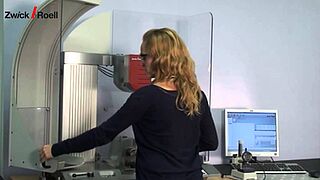ASTM D256 - 一個涉及各種測試方法的標準
測試結果表示為與試樣厚度的相關能量吸收。
- Method A is used for plastics with an Izod notched impact strength greater than or equal to 27 J/m. In this case, a notch radius of 0.25 mm is used. The result is calculated directly from the height of rise of the pendulum hammer after the impact.
- Method C is used for very brittle plastic materials with an Izod notched impact strength of less than 27 J/m. It corresponds to Method A, however the measured impact energy is corrected by the amount of the calculated centrifugal work of the specimen.
- Method D is used to characterize the notch sensitivity of a polymer material. Here, the notched impact strength is measured on specimens with different notch radii, and the notch sensitivity is calculated as a linear gradient over the notch radius.
- 對於此方法,將夾持試樣並旋轉180°,使缺口的位置相對於衝擊方向。該結果只能條件性地與無缺口試樣測試進行相比。
ASTM D256試樣及尺寸
符合ASTM D256標準的試樣外部尺寸被規定為長2.5英寸(63.5 mm),高0.5英寸(12.5 mm)。對於由組件加工成的試樣,其組件的壁厚通常決定了寬度。
- For the commonly used Method A, a notch with a radius of 0.25 mm and an angle of 45° is milled into the specimen so that a height of 0.40 in (10.16 mm) remains at the base of the notch.
- If the notch sensitivity is to be measured according to Method D, the specimens must be prepared with different notch radii. In addition to the standard notch according to Method A, specimens are machined with a notch radius of 0.04 in (1.0 mm).
The ZNO motorized notch cutting machine with a standard-compliant single tooth cutter is available for notch preparation. For smaller specimen quantities, we recommend the manual notching plane with automatic infeed movement.
For the test, it is important that the notch is placed exactly in the area of the greatest bending moment. Therefore, the specimens are either positioned using a height stop, or precisely and reliably aligned with a notch alignment unit integrated in the impact fixture.
Izod懸臂樑和Charpy簡支樑方法之間的差異
兩種方法都以非常相似的方式表徵材料的衝擊強度,因此結果很大程度地相關。
- ASTM 標準中通常使用Izod 測試法,其中試樣被垂直放置。
- 採用三點彎曲佈置的Charpy 衝擊試驗為 ISO 標準中的首選方法。
- 這兩種方法都用於測量缺口衝擊強度,為此帶缺口的試樣被衝擊,使缺口位於由衝擊所引起的彎曲拉伸區。對於Izod懸臂梁試驗,此拉伸區域位於擺錘的衝擊側,而對於Charpy試驗則位於相反側。
- Charpy 法在低溫下進行測試時具有多種優點,因為擺錘衝擊試驗機中試樣的接觸點距離擺錘的衝擊點相對較遠。如此一來,溫度就不會受到相關區域中支撐件的影響或降低,並且可以輕鬆地從溫控箱供給試樣。
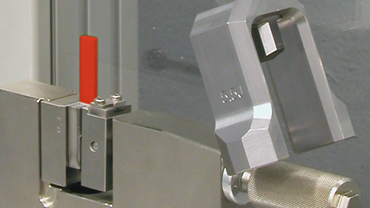
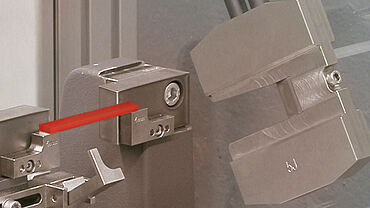
抗衝擊性是如何計算出的?
A conventional Charpy or Izod impact test, measures the impact energy emitted by a pendulum hammer when striking through the specimen. This energy can easily be determined from the difference between the release height of the pendulum hammer and its height of rise after the impact. In the ISO standards, the impact energy is related to the cross-sectional area of the specimen and given in [kJ/m²], while in ASTM standards it is common to relate this energy to the thickness of the specimen to indicate an impact strength value, for example, in [ft lbf/in].
什麼是缺口衝擊強度?
When testing an unnotched specimen, the result is called impact strength or impact resistance, while tests carried out on notched specimens determine their notched impact strength or resistance.

Optimale Integration der Prüfung nach ASTM D256 durch die Prüfsoftware testXpert
Eine Prüfsoftware für alles: die Schlagzähigkeitsprüfung nach ASTM D256, die Zugprüfung, die Biegeprüfung, die Fließprüfung. Und alle Daten lassen sich zusammen auswerten.
- Zahlreiche Import- und Export-Möglichkeiten sichern die ideale Einpassung von testXpert und der Schlagzähigkeitsprüfung nach ASTM D256 in Ihre Prozesse. Automatisch liest die Prüfsoftware Daten aus anderen Systemen ein und aus, zum Beispiel aus Ihrem firmeneigenen ERP- oder LIM-System.
- Die Messung der Probendimensionen nach ASTM D256 ist integriert: Restbreite, Höhe und Breite der Probe werden beim Messen auf Knopfdruck vom Messgerät an testXpert weitergeleitet.
- Alle Kennwerte aus Schlagzähigkeitsprüfung nach ASTM D256, Zugprüfung, Biegeprüfung und Fließprüfung werden gemeinsam in einer Datenbank gespeichert. Die Prüfdaten sind einfach wiederzufinden, auszuwerten und zu vergleichen – über alle Anwendungen hinweg. Der Zugriff erfolgt einfach über Webbrowser – von wo immer Sie möchten.
- Die Trend Analysis bietet eine einfache Qualitätsregelkarte (SPC), damit erkennen Sie frühzeitig Abweichungen zu den Qualitätsvorgaben.
Frequently asked questions about Izod impact strength to ASTM D256
ASTM D256 is the international standard for determination of the impact strength of plastic and insulation materials.
The ASTM D256 standard describes impact testing using the Izod test method for determination of the impact strength and notched impact strength of plastics. Izod impact tests are also described in standards ISO 180 and ASTM D4508.
ASTM D256懸臂樑缺口衝擊試驗以厚度相關能量值的形式生成高應變率下的抗衝擊性 和缺口敏感性特徵值。根據 ASTM D618,測試通常在 23°/50% 相對濕度的正常氣候下進行。
It is used to determine the comparability of different molding compounds, tolerance monitoring within the scope of goods inwards checks and quality assurance, testing of finished parts based on machined specimens, creation of material cards and for measurement of aging effects.
- ASTM D256懸臂樑缺口衝擊試驗以厚度相關能量值的形式生成高應變率下的抗衝擊性 和缺口敏感性特徵值。
- ASTM D4812,一種用於測量無缺口試樣衝擊強度的Izod測試方法
- ASTM D4508,一種用於測量小試片(薄片衝擊)的Izod式測試,它與符合 DIN 53435 的 Dynstat 彎曲衝擊測試相對應。
- ISO 180 描述了用於測定塑料衝擊強度和缺口衝擊強度的Izod衝擊試驗。它以橫截面相關值的形式提供高應變率下衝擊強度的特徵值。
Both test methods characterize the impact strength of a plastic material. The Izod test method, in which the specimen is positioned vertically, is normally used in ASTM standards. The Charpy method, which uses a three-point bending arrangement, is the preferred method in ISO standards.
這兩種方法都用於測量缺口衝擊強度,為此缺口試樣被敲擊,使缺口位於衝擊引起的彎曲的拉伸區。
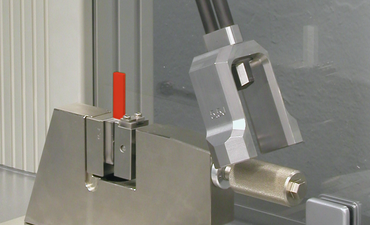
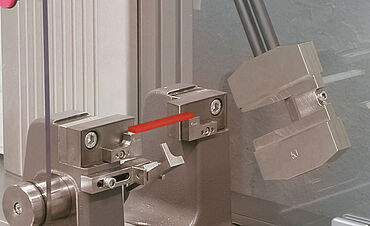
A Charpy or Izod impact test measures the impact energy emitted by a pendulum hammer when striking through the specimen, which can be determined from the difference between the release height of the pendulum hammer and its height of rise after the impact. In the ISO standards, the impact energy is related to the cross-sectional area of the specimen and given in [kJ/m²], while in ASTM standards this energy is related to the thickness of the specimen to indicate an impact strength value, for example, in [ft lbf/in].
